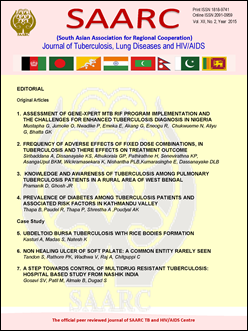A Step towards Control of Multidrug Resistant Tuberculosis: Hospital Based Study from Nashik India
DOI:
https://doi.org/10.3126/saarctb.v12i2.15971Keywords:
Outcome, Multi drug resistance, Tuberculosis, TreatmentAbstract
Introduction: The Global TB report (2012), estimates 73,000 MDR TB patients living in India, among them only 1,660 cases were notified and 68.4% cases were put on treatment. Hence, this study was conducted with objective to assess the treatment outcome of multi drug resistant Tuberculosis patients enrolled in DOTS plus (Cat-VI) site.
Methodology: It is a retrospective case series of MDR-TB cases conducted at Dr. Vasantrao Pawar Medical College, Hospital & Research Centre, Nashik (Maharashtra). Information was collected on age, gender, HIV status, previous treatment of TB, weight of patient, refused to take treatment for Cat IV. Outcome was recorded in terms of cure rate, rate of failure, defaulter, treatment completed, switch to Cat V and death.
Results: Among the study subject, majority of study subjects were male (65%) and highest proportion (49%) of MDR-TB was in 25-44 years of age. Out of 353 patient 241 (68.4%) were still on Cat IV in which 35% patient’s on intensive phase and 65% put on continuation phase while 12.8%, 13.5%, 4%, 1.1%, 3.6% & 0.5% patient were found to be defaulted, died, refused to take treatment, treatment completed, transfer out & switch to Cat V, respectively.
Conclusion: In the present study, the majority of study subjects (99.4%) were previously treated for TB, we identified number of operational challenges in the treatment of MDR-TB like rate of defaulter, refuse to take treatment & deaths among MDR-TB patient was high. There is need to study correlates of these factors in details also need of operational research to improve MDR-TB treatment in India is considered as priority.
SAARC J TUBER LUNG DIS HIV/AIDS, 2015 XII (2), page: 34-38
Downloads
Downloads
Published
How to Cite
Issue
Section
License
Copyright © SAARC Tuberculosis and HIV/AIDS Centre (STAC), all rights reserved, no part of this publication may be reproduced, stored in a retrieval system or transmitted in any form or by any means without prior permission of the STAC.




